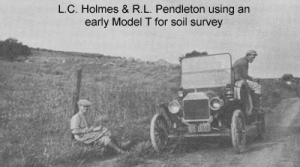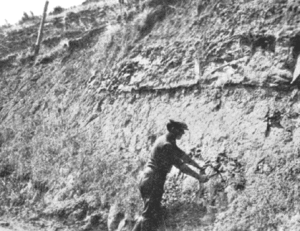By William R. Reed
Professor Charles F. Shaw
Professor Charles Shaw was hired in 1913 by University of California, Berkeley College of Agriculture Dean, Thomas Forsyth Hunt. This move signaled a dramatic shift for Soil Survey efforts in California. Professor Charles Shaw, who had been a student of Dr. Jay Bonsteel at Cornell where he received a Bachelor’s degree in 1906, had an extensive history with the Bureau of Soil Surveys. Professor Shaw began working for the Bureau of Soils in 1905 and was hired at Pennsylvania State University in 1907. Five reconnaissance soil surveys were completed by Professor Shaw during summer months while teaching and researching at Pennsylvania State University during 1910 to 1913. [Pennsylvania State Soil Survey History] Professor Shaw worked on staff with another soil scientist, Hugh Hammond Bennett who later led the Soil Conservation Service in the mid 1930s.
Professor Shaw was ideally suited to bridge the chasm between Dr. Hilgard and Milton Whitney of the Bureau of Soils. His extensive Soil Survey experience provided the background to launch greatly expanded Soil Survey efforts in California. The Bureau of Soils had completed many early Soil Surveys prior to 1913 but there seemed to be little state wide coordination. Hans Jenny writes rather sorrowfully that the arrival of Professor Shaw completed the eclipse of Dr. Hilgard. Yet this writer suspects that the 45 years of research and study that have transpired since Hans Jenny completed his great biography of Hilgard have opened other views of Hilgard and his position in history. No doubt Hilgard was dismayed at being the first UC professor to be automatically retired on reaching retirement age. Hilgard was also disillusioned that Whitney’s Soil Surveys were expanding across the Nation with increasing funding. But by 1913 Hilgard was 80 years old and would only live another 3 years to barely see the Reconnaissance Soil Surveys started in California. Whitney’s views on plant nutrition did not prevail in the long run and Hilgard was not alone in his protest of them. Charles Shaw brought cooperation with the Bureau of Soils to California, which proved to be a very positive change, accelerating the Soil Survey efforts in the state. Shaw’s academic work set the stage for the development of Soil Taxa for the diverse soils on California’s landscapes, the organization of what grew into the UC Soils 105 field course and the initiation of the UC Division of Soil Survey. Always popular with students and a particularly good friend with Macy Lapham, the work of this man remains largely unknown even in the soil science community. Ahead is a brief study of some of the highlights of Shaw’s career, a thorough study remains to be done and properly published to give him his due credit in the history of the soil survey in California.
Historic Cooperative Agreement
The year 1913 brought the historic Cooperative Agreement between the University of California Extension and the Bureau of Soils for soil surveys in the State of California. This historic agreement was signed by Dean Hunt, Professor Charles Shaw and Macy Lapham representing the Bureau of Soils. Macy and Charles Shaw were to become close friends. The first order of business was to rapidly complete Reconnaissance Soil Surveys across the agricultural regions of the state to ascertain the most immediate needs for Soil Surveys and the extent of those areas. For the next 5 years these Reconnaissance Soil Surveys were conducted across the State in the Sacramento Valley, the upper, middle and lower San Joaquin valley, the San Francisco Bay Region, the Southern Central Region and the San Diego Region.
After the completion of the Reconnaissance Soil Surveys in 1918, Soil Survey efforts expanded in California with survey staffs combined with Bureau of Soils personnel and University of California personnel. Twenty-three Soil Surveys around California were completed by these combined soil survey staffs in the 1920s.






